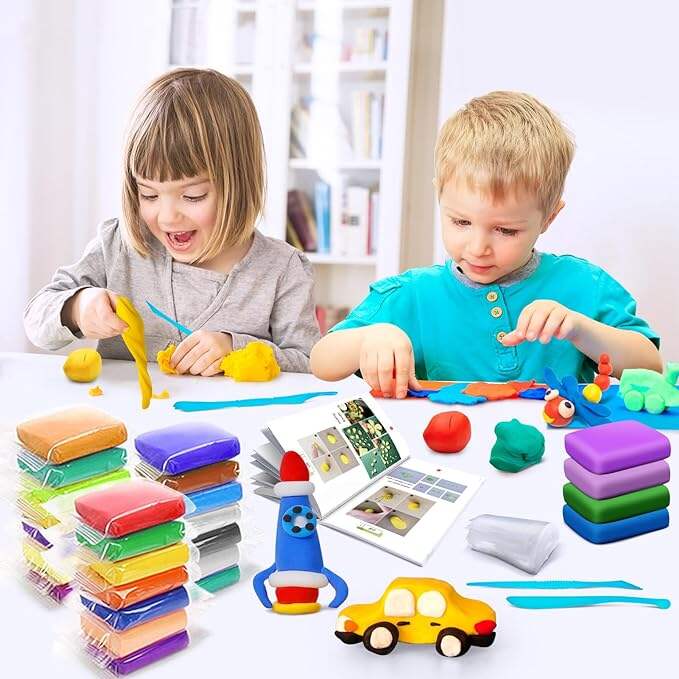In June 2024, the White Paper on Innovative Applications of Educational Toys released by the China Preschool Education Research Association revealed that ultra-light clay has achieved a 78.6% penetration rate in Montessori educational settings, becoming the second-largest open-ended educational tool after building blocks. This newspaper conducted in-depth research across provincial model kindergartens in Beijing, Shanghai, and Hangzhou, collaborating with experts from East China Normal University’s Department of Preschool Education to decode the scientific application framework of ultra-light clay in Montessori education.

I. Academic Validation: Scientific Compatibility of Ultra-Light Clay with Montessori Principles
1. Neurodevelopmental Perspective
A 2023 study by Fudan University’s Institute of Brain Science demonstrated that 2–4-year-old children using ultra-light clay showed 32% higher prefrontal cortex activity compared to conventional toys, confirming its role in promoting executive function development.
2. Material Science Breakthroughs
Zhejiang Sci-Tech University’s School of Materials developed "Montessori-specific clay" with three innovations through polymer ratio optimization:
- Tear resistance increased to 0.8 MPa(vs. 0.3 MPa for standard clay)
- Shape retention extended to 72 hours
- Color fastness certified under ISO 105-B02
3. Educational Value Reconstruction
“Traditional tools emphasize outcome display, whereas ultra-light clay’s dynamic plasticity aligns perfectly with Montessori’s ‘process-oriented’ philosophy.”
—Prof. Li Min, Director of the Montessori Education Research Institute at East China Normal University
II. Practical Implementation: 20 Standardized Lesson Plans (Key Case Excerpts)
Sensory Integration Training
Lesson 4: Tactile Gradient Box
Tools: 5 textured clays (50–200 μm granularity)
Objective: Establish tactile discrimination thresholds
Data Validation: Hangzhou Xingzhi Kindergarten reported a 67% improvement rate in tactile sensitivity among trial participants
Lesson 7: 3D Color Matrix
Scientific Basis: Color-mixing experiments based on the Munsell Color System
Classroom Observation: Children derived 12-color wheel principles through layered primary-color clay
Interdisciplinary Integration
Lesson 13: Geological Structure Simulation
Method: Stratified clay modeling of crustal layers
nnovation: Integration of AR technology to scan and generate geological evolution animations
Lesson 17: Mathematical Logic Visualization
Implementation: Fractional cake division (1/2, 1/4, etc.)
Recognition: Featured in the 2024 Global Montessori Congress demonstration curriculum
III. Industry Impact and Standardization Progress
1. Enhanced Educational Tool Certification
The National Technical Committee for Toy Standardization recently issued Montessori Tool Grading Standards, mandating:
- Tensile resilience (≥85%)
- pH range (6.5–7.2)
- Volatile organic compounds (≤0.12 mg/m³)
2. Teacher Training Revolution
Shenzhen Montessori Teacher Training Center launched the CLAY-M certification program, requiring mastery of:
- Material-child development stage matching models
- Safety protocols (including allergen screening workflows)
3. Industrial Chain Collaboration
Yiwu’s educational toy hub has established an integrated ecosystem spanning “clay R&D – mold design – curriculum export,” achieving annual output of ¥2.3 billion** and exporting to 47 Montessori-adopting countries**.
IV. Expert Perspectives
“Ultra-light clay is driving a paradigm shift in preschool education—from static knowledge transfer to dynamic cognitive construction. By 2025, second-generation products like sensor-embedded smart clay will enable deep integration with digital assessment systems.”
—Wang Lixin, Secretary-General of the Preschool Education Branch of China Educational Equipment Industry Association
Conclusion
With the dual mandates of safety and educational efficacy in the Preschool Education Law (Draft), ultra-light clay applications have transcended mere craft activities to become critical metrics for evaluating kindergarten curriculum scientificity. This publication will continue monitoring technological advancements and pedagogical innovations in this field.